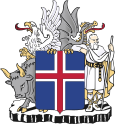 |
|---|
The regions of Iceland are eight areas of Iceland that roughly follow the arrangement of parliamentary constituencies as they were between 1959 and 2003. These regions are not incorporated polities but rather recognized groupings of municipalities. Iceland only has two levels of administration, the national government and 62 municipalities. The municipalities have organized themselves into eight regional associations [1] and those boundaries are also recognized by Statistics Iceland to report statistics. [2] Since 2014, police and commissioner ( sýslumaður ) districts have followed the eight region model with the exception that Vestmannaeyjar forms a special district and not part of the Southern Region. The divisions of Iceland for the purposes of health care and district courts diverge more from the commonly used eight region model.
Contents
The postal code system also roughly corresponds with the regions with the first digit of the three digit codes usually being the same as on the map below.

